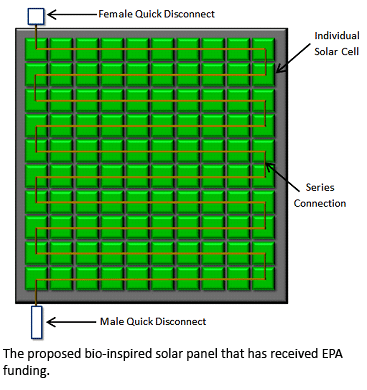Engineering seniors design a bio-inspired solar cell with EPA funding
[Originally published by Vanderbilt School of Engineering]
A team of Vanderbilt engineering seniors has been awarded $15,000 by the U.S. Environmental Protection Agency (EPA) to design a nature inspired large-scale solar cell. The students, under the guidance of Kane Jennings, associate professor of chemical and biomolecular engineering and Amrutur Anilkumar, professor of the practice of mechanical engineering, participating in this interdisciplinary senior design project include: Andrew Couch, Eric Dilbone, Philip Ingram, Trevan Locke, Paul McDonald and Jason Ogg with junior chemistry student Melinda Shearer assisting the team.
The awards were given through the EPA’s People, Prosperity and the Planet (P3) Program, a national competition that challenges students, working together on interdisciplinary teams, to design and build sustainable technologies that improve quality of life, promote economic development, and protect the environment. A total of 45 grants have been awarded to colleges and universities across the country for the 2011-2012 Phase I competition.
The Vanderbilt team aims to build a novel, large-scale biohybrid solar panel for power production from many individual photoelectrochemical cells that employ photosynthetic proteins as the active elements for light-harvesting and energy conversion.“It is a proof of concept work that is not ready for the marketplace, but has the power to inspire,” Anilkumar said.
 When EPA put out a call for proposals for student projects in the energy arena last spring, Anilkumar suggested the scale-up approach to Jennings, who has pioneered the work on bioinspired photocells by extracting a specific plant protein (Photosystem I) and depositing it in multilayer films on non-biological substrates.
When EPA put out a call for proposals for student projects in the energy arena last spring, Anilkumar suggested the scale-up approach to Jennings, who has pioneered the work on bioinspired photocells by extracting a specific plant protein (Photosystem I) and depositing it in multilayer films on non-biological substrates.
The senior designers propose to construct modules with about 1000 of these centimeter-sized cells and use a quick connect method to assemble a 6’ x 6’ solar panel. There are plans to field test the bio-inspired solar panel at the Vanderbilt-MWS Love Circle Alternative Energy site in by next spring.
“The current solar energy conversion efficiencies of these cells are not comparable to silicon-based devices. However, a project like this is a showcase project that aims to prove that a combination of nature and engineering may hold the keys to energy challenges,” says Professor Jennings.
The annual competition begins in Phase I with the award of $15,000 grants to student teams who focus on a wide range of categories including water, energy, agriculture, built environment, and materials and chemicals. After working on the project for eight months, the teams will take their designs to the 8th Annual National Sustainable Design Expo on the National Mall in Washington, D.C. At the expo, the projects will be judged by a panel of experts and a select few will be awarded P3 Awards and Phase II grants up to $90,000 for students to further their designs, implement them in the field, or move them to the marketplace.
Applications are being accepted through Dec. 22, 2011, for the next round of Phase I awards for the 2012-2013 school year. In addition to the categories above, teams can also propose innovative ideas for green infrastructure and designing clean cookstoves.

Leave a Response